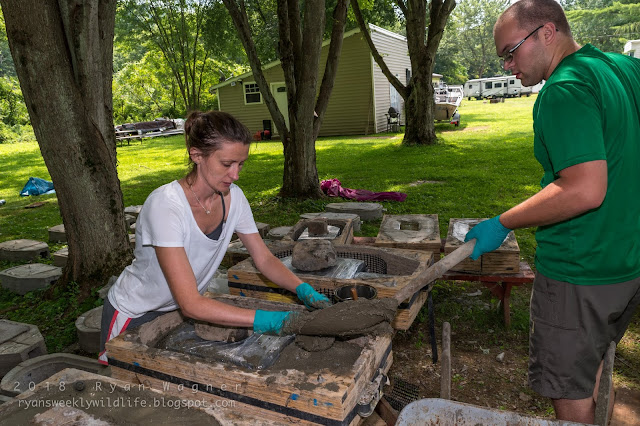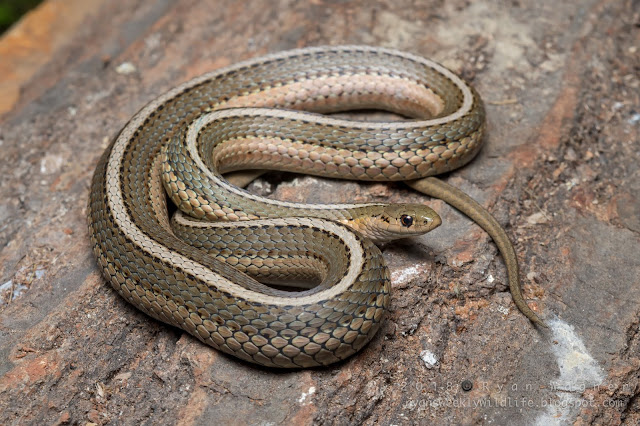Short-headed garter snakes (Thamnophis brachystoma) only occur in one or two counties in extreme eastern Ohio. Truth be told, it isn’t even known whether they are true natives to the buckeye state. It is possible they have expanded their range or have been introduced from Pennsylvania, one of only two other states they are known from (the other being New York). Growing just over a foot in length, the short head is an inhabitant of fields and meadows along waterways. These elegant earthworm eaters are much smaller than the eastern gartersnake, with a narrow, neckless head and pleasing tan and gray stripes. They are a species I had written off. The likelihood of encountering one was just too slim. I’d have to travel to PA to find one, and even then, where would I start my search?
Luck would have it that Dr. Popescu’s new PhD student, Matt Kaunert, was beginning his project smack dab in the middle of their range. Within an hour of our arrival in northwestern Pennsylvania, he found us three individuals (and seven eastern garters). This was going to be a trip to remember. Andrew Travers, Christine Hanson, and myself had traveled the five hours from Athens, Ohio to help him begin his project. Matt was studying another rare species of herp I never imagined I would get to see: North America’s largest salamander species, the eastern hellbender (Cryptobranchus alleganiensis).
That morning, Matt had driven to check each of the creeks we were scheduled to survey, and his report didn’t look good. It had rained the previous night, and the normally clear streams were now cloudy with sediment and debris. Visibility would be so poor that finding the large, flat rocks hellbenders like to hide under would be next to impossible. Even if we could stumble upon a suitable rock, the water would be too murky to see anything lurking below. We would have to wait and hope for dry weather and check the streams again in two days. In the meantime, we would get started on another aspect of his project: building hellbender nest boxes.
Matt led us to his family’s campground where he was preparing for the field season. We crept down the dirt road at 5 miles an hour and emerged into a neighborhood of little, ramshackle buildings and trailers in varying states of disrepair. Not 200 meters from their back porches, the enormous river flowed under a skyline of forested hills. Kayakers drifted lazily along as juvenile bald eagles soared overhead, practicing their flying. I felt goosebumps rise on my arms at the thought of hellbenders hiding just feet below the water’s surface. Matt’s camp was a delightful, two room trailer-mobile home hybrid, with running water, four beds, and a flat screen TV. Out back, sat several rows of what appeared to be miniature, concrete coffins.
Each coffin was about a meter long, with a rounded top that narrowed into an open tunnel at the base. A removable lid provided full access to the hollow interior of the concrete box. Placed in the appropriate streams, these baby coffins should mimic the natural rock cavities that hellbenders require to reproduce. Matt has already completed some 60 nest boxes and hopes to nearly double that by the time he gets the go ahead to deploy them.
 |
| Christine Hanson and Andrew Travers working on a nest box. |
Once the four new boxes were set, we had the rest of the day to enjoy ourselves. We went herping of course. The day was simply gorgeous, mid-seventies with a cool breeze and clear, blue skies; we were all itching to get on the water. We loaded canoes and paddle boards into the truck and headed for the river. Matt had turtles on the brain. Spiny softshells and snappers are a common sight basking along the shore, but it takes lightning fast reflexes to catch them before they slip into the water. I’d never herped by canoe before; it is definitely one of the more relaxing ways to seek slimy and scaly creatures. We drifted along (I let Andrew do most of the paddling), scanning the banks for signs of turtles. “They will look like a shiny pancake,” Matt said, referring to the spiny softshells. Matt went into full paddle, standing on his canoe, heading for a series of rocks. I watched as several shiny circles plopped into the stream long before Matt reached them. Luckily, he wasn’t deterred.
Matt has herped this river ever since he was a boy. He knows the best spots and has encountered just about every creature that can be found here. Where the rest of us had just seen mud, he pried an enormous snapping turtle from the muck with a grin. He taught us how to feel for softshells with our feet and crept up sandbars on his belly—a trick to spot turtles before they disappear into the water. As we paddled back towards camp, Matt saw something on the bank none of us had noticed. He leapt from his canoe, clipping his eyelid on a branch, and pinned a softshell turtle in the water. With blood streaming down his face, he lifted the struggling turtle—larger than a dinner plate—and placed it on the bank for us to photograph.
Eastern spiny softshells (Apalone spinifera) are an impressive creature. They display all the ferocity of a snapping turtle with the agility of a frog. They launch themselves into the water leaving nothing but a trail of sediment in their wake. A snorkel-like snout and a serpentine neck allow them to reach the surface for air while remaining buried in the sediment. Softshells are essentially a river turtle and can be quite common throughout Ohio and western Pennsylvania. I had never seen one so large—having caught only young individuals on the OU campus.
It seemed the weather was not going to cooperate for our hellbender survey. That night, the forecast called for rain. We tried to will the storm past, but as the winds picked up, a heavy thunderstorm swept through camp, extinguishing our electricity and with it the last of our hellbender hopes. We went to bed with heavy hearts.
We woke late the next morning, packed our gear and headed for one of the survey streams. Matt craned his neck to peer through the passenger window at the murky creek flowing below. “Uh oh,” he said distantly. Seeing my crestfallen expression, he added, “uh oh in a good way.” The water was the color of tea, but even from the road I could see large slabs of rock resting several inches below the surface. Despite the rains, the river had cleared significantly. “Let’s take a drive,” Matt said with growing confidence.
Hellbender Hopes. To be continued. . .













No comments:
Post a Comment